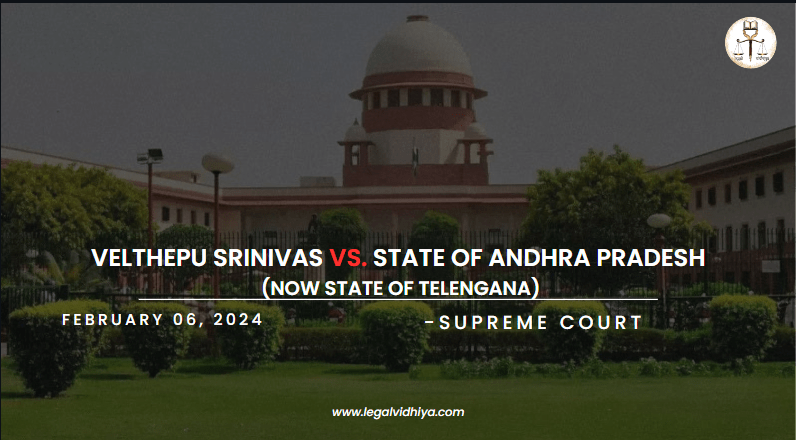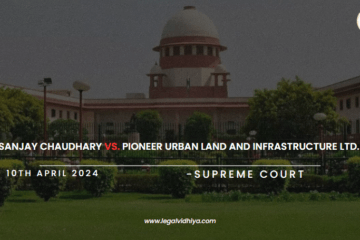
| CITATION | Criminal Appeal no. 2852 of 2023 |
| DATE OF JUDGMENT | February 06, 2024 |
| COURT | Supreme Court of India |
| APPELLANT | Velthepu Srinivas and other |
| RESPONDENT | State of Andhra Pradesh (Now State of Telengana) |
| BENCH | Hon’ble Mr. Pamidighantam Sri Narasimha and Hon’ble Mr. B.R. Gavai |
INTRODUCTION
The case concerns a criminal appeal (No. 2852 of 2023) filed with the Supreme Court of India, Criminal Appellate Jurisdiction. The appellants (accused 1–4) are challenging their concurrent convictions under Section 302 read with Section 34 of the IPC, as well as the life sentence given by both the Trial Court and the Telangana High Court. The fundamental issue is the murder of the deceased, which resulted from political competition within the same hamlet.
FACTS OF THE CASE
- The deceased and the accused, all four of them are from Janda Venkatpur, Asifabad, Telangana, and they are members of the same family.
- During the Gramme Panchayat elections, there was a political dispute between the deceased’s sister and A-4’s wife, which is said to be the reason behind the murder.
- The deceased suffered fatal injuries and severe injuries after the accused attacked him in an autorickshaw outside of A-4’s residence on November 15, 2001, around 8 AM.
- At nine o’clock at night, Kona Kiran Kumar, the deceased’s son, called the police to report the event.
- The Circle Inspector of Police carried out an inquiry, confiscated pertinent objects, and took witness accounts, designating some as eyewitnesses.
- Dr. Victor Dinesh (PW-11) performed a post-mortem examination, which found several slashed wounds and injuries. The examination concluded that the cause of death was a cardio-pulmonary arrest brought on by a transverse spinal cord at the atlanto-occipital joint.
- During the trial, the accused’s confessions and the weapons’ discovery were utilised as supporting documentation.
- The Trial Court, in 2005 sentenced all four of the accused to life in prison with fine after finding them guilty under Section 302 read with Section 34.
- The defendants were first found not guilty by the High Court; however, their conviction was upheld by the Supreme Court after an appeal, and the matter was returned to the High Court.
- The present appeal resulted from the High Court upholding the Trial Court’s decision following remand.
ISSUES RAISED
- How trustworthy and consistent is the eyewitness’s testimony?
- Did the accused act intending to commit the offence together or not?
- How strong is the evidence against A-3, and how does Section 34 apply to him?
CONTENTIONS OF PROSECUTION
- The prosecution contended that PWs 1, 3, 4, 6, 7, and 8’s eyewitness testimony offered a coherent description of the occurrence, supporting the sequence of events leading up to the murder.
- The veracity of these eyewitnesses and their consistency about the weapons, injuries, and murderous motivation were highlighted by the High Court.
- Invoking Section 34, the prosecution contended that all of the accused, including A-3, had a common intention to commit the crime.
CONTENTIONS OF DEFENDANT
- The defence questioned eyewitness credibility, pointing to inconsistencies in comments made about the attack.
- It was contended that inadequate evidence supported A-3’s shared intention with the other defendants, and that his involvement in the crime was not sufficiently investigated.
- The defence contested the applicability of Section 34 to A-3, highlighting the lack of proof proving his direct participation in the killing.
JUDGEMENT
According to the Supreme Court’s ruling, the Trial Court and the High Court found the eyewitness accounts—especially those of PW-1, PW-3, PW-4, PW-6, PW-7, and PW-8—to be believable and consistent. The testimony of the accused was deemed credible by the courts as it provided details about the murderous sequence, the weapons utilised, and the respective roles of the parties involved. In order to prove the accused’s guilt, the courts thoroughly investigated and verified the testimony of the eyewitnesses. The conviction and punishment of A-1, A-2, and A-4 under Section 302 read with Section 34 were upheld by the Supreme Court. A-3’s conviction was changed to Section 304 Part II, nonetheless, in recognition of his unique position and absence of a group murderous purpose. The ground for this change was established by precedents, including Camilo Vaz v. State of Goa (2000) 9 SCC 1.
A-3 ought to have understood that striking the dead person in the head with a stone could be fatal. But there’s not enough evidence to conclude he planned to commit murder with the others, according to court cases such as Bawa Singh v. State of Punjab, 1993 Supp (2) SCC 754 and others. Accordingly, A-3 is found guilty of causing unintentional hurt that results in death under Section 304 Part II IPC.
ANALYSIS
After closely examining the eyewitness testimony, the Trial Court and High Court concluded that A-3 and the other defendants had the same intention under Section 34. But not enough emphasis was placed on A-3’s unique function and the lack of proof proving his intention to kill. Differentiating the responsibilities of the accused was made possible in large part by the post-mortem report.
CONCLUSION
The case underlines how crucial it is to carefully consider each person’s contribution to a crime and make sure that convictions reflect the distinct deeds and goals of each accused party. In order to ensure justice while taking into account the particulars of each case, the judgement clarifies how various provisions should be applied in light of the evidence that was submitted. Also the verdict of the court finding A-3 guilty under section 304 of IPC, this ruling is the result of a careful examination of the available data and a legal interpretation that complies with the standards set forth in pertinent court decision.
REFERENCES
https://indiankanoon.org/doc/85987296/
This article is written by Ankita Maurya student of Graphic Era Hill University, Dehradun; Intern at Legal Vidhya.
Disclaimer: The materials provided herein are intended solely for informational purposes. Accessing or using the site or the materials does not establish an attorney-client relationship. The information presented on this site is not to be construed as legal or professional advice, and it should not be relied upon for such purposes or used as a substitute for advice from a licensed attorney in your state. Additionally, the viewpoint presented by the author is of a personal nature.






0 Comments